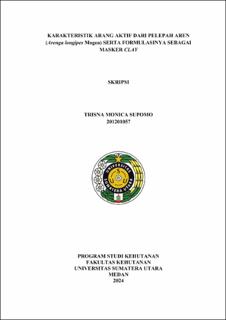| dc.description.abstract | Activated carbon is.one.of.the.needs in the industrial sector in.Indonesia, one of
which is the cosmetics industry. Palm fronds (Arenga longipes Mogea) are one of
the potential raw materials for activated charcoal. This study aims to characterize
activated charcoal from palm fronds and its formulation as a clay mask. This
study used a physical gradual activation treatment (high temperature) and
continued with chemical activation (ZnCl2). Characterization of palm frond
charcoal based on test parameters, namely water.content, ash.content, .and fly
substance content.with.a charcoal size of 100 mesh. Testing of clay mask
preparation includes organoleptic test, pH test, homogeneity test, drying time test,
and irritation test using 12 volunteers. The results showed that almost all
parameters met SNI 06-3730-1995. The results showed the weight change value
ranged from 0.19-0.28%; moisture content 0.14-0.19%; ash content 0.1-0.29%;
volatile substance content 0.43-0.64%; and bound carbon content 99-99.12%.
The results of the characteristic examination of the preparations' organoleptic test
showed that the variations in chemical activation treatment using ZnCl2 of 0%,
1%, 3%, and 5% did not change the shape, color and smell. Based on
homogeneity testing, the preparation showed homogeneity. The pH test yielded a
range of 5.7-6.1. The drying test resulted in 10-11 minutes, and the skin irritation
test on volunteers showed no irritation on the skin. Based on the results of the
analysis, it can be concluded that activated charcoal from palm fronds that have
been treated with activation has the potential to be an adsorbent medium for
cosmetic raw materials in the form of clay masks. | en_US |


